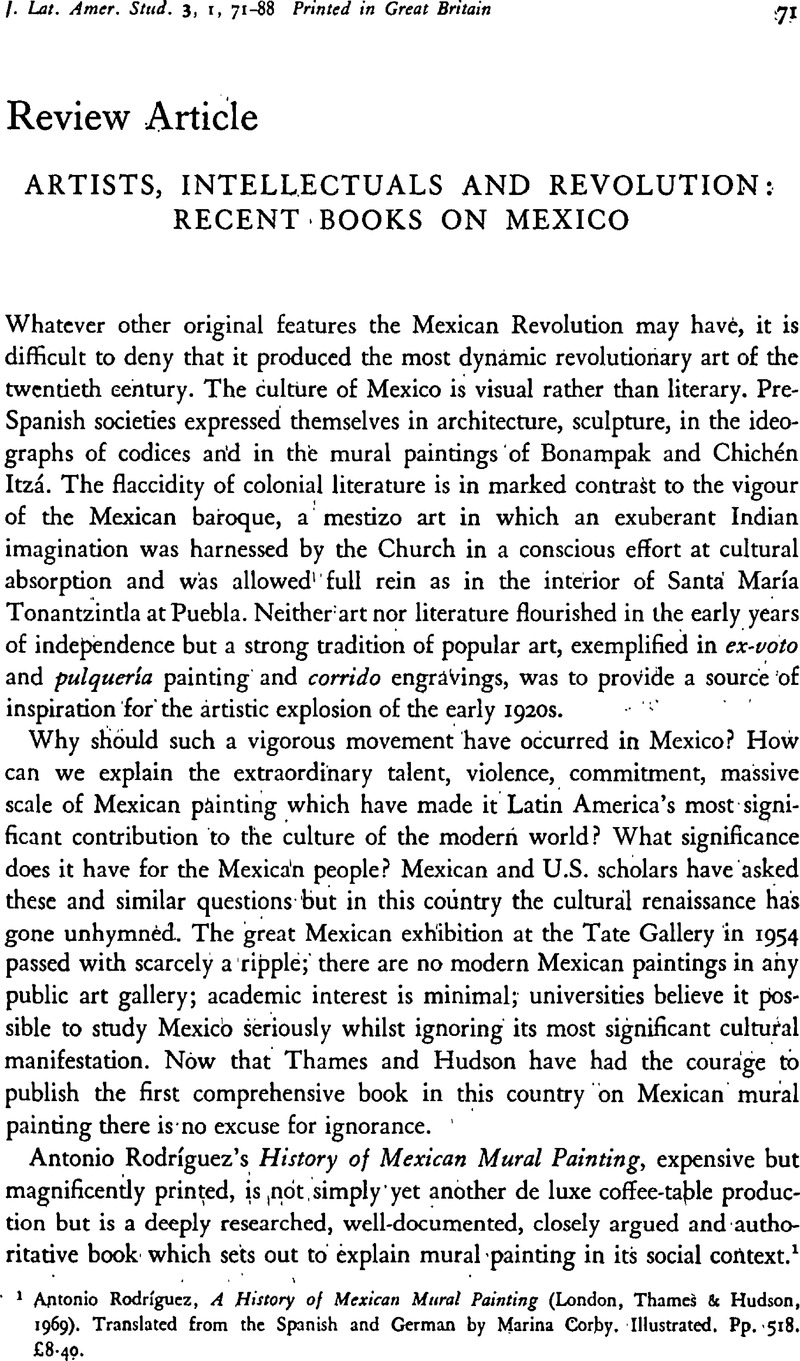Published online by Cambridge University Press: 05 February 2009

1 Rodrígucz, Antonio, A History of Mexican Mural Painting (London, Thames & Hudson, 1969)Google Scholar. Translated from the Spanish and German by Corby, Marina. Illustrated. Pp. 518. £8.40.Google Scholar
2 Wolfe, Bertram D., The Fabulous life of Diego Rivera (London, 1968)Google Scholar; Myers, Bernard S., Mexican Painting in Our Time (New York, 1956)Google Scholar; Fernandez, Justino, Arte moderno y contemporáneo de México (Mexico, 1952)Google Scholar; Aragon, L. Cardoza y, Orozco (Mexico, 1959)Google Scholar; Reed, Alma, Orozco: Man of Fire (New York, 1956)Google Scholar and her The Mexican Muralists (New York, 1960); Tibol, Raquel, Siqueiros (Mexico, 1961)Google Scholar. The most recent and comprehensive treatment before Rodriguez was Edwards, Emily and Bravo, Manuel Alvarez, Painted Walls of Mexico (University of Texas Press, 1966).Google Scholar
3 Charlot, Jean, Mexican Mural Renaissance, 1920–1925 (Yale University Press, 1963).Google Scholar
4 I am examining this, together with other questions such as the overlapping of elites, in a forthcoming study of culture and society in Mexico since 1910.
5 An interesting study of the cinema is Blanco, Jorge Ayala, La Aventura del Cine Mexicano (Mexico, Ediciones Era, 1968).Google Scholar
6 This story has been recently told by Geduld, Harry M. and Gottesman, Ronald S., Sergei Eisenstein and Upton Sinclair: the making and the unmaking of Que Viva México (London, 1970)Google Scholar. Buñuel has perhaps been the most important influence.
7 See the article by Brown, John, ‘Exuberancia Mexicano-Norteamericana, 1920–40’ in Anglia: Anuario de Estudios Angloamericanos, 1 (1969)Google Scholar, the new journal published by UNAM and edited by Dra Vázquez de Knauth which deserves to be brought to the notice of English specialise. The books include Brenner, Anita, Idols Behind Altars (New York, 1929)Google Scholar; Toor, Frances, A Treasury of Mexican Folkways (10th Printing, illustrated by Carlos Merida, New York, 1964)Google Scholar and Gruening, Ernest, Mexico and its Heritage (New York, 1929).Google Scholar
8 Cuevas, J. L., ‘The Cactus Curtain. An Open Letter on Conformity in Mexican Art’, Evergreen Review, 7 (1959).Google Scholar
9 de Knauth, Josefina Vázqucz, Nacionalismo y Educatión en Mexico (Mexico, El Colegio de México, Centro de Estudios Históricos. Nueva Serie 9, 1970). Pp. 291, n.p.s.Google Scholar
10 Sierra, Justo, The Political Evolution of the Mexican People. Translated by Ramsdell, Charles. With an introduction by Edmundo O'Gorman and a prologue by Alfonso Reyes (Austin and London, Texas University Press, 1969). Pp. xx + 406. £4.05.Google Scholar
11 Cockcroft, James D., Intellectual Precursors of the Mexican Revolution, 1900–1913 (Austin and London, University of Texas Press, 1968). Pp. 329. £4.05Google Scholar. Institute of Latin American Studies Monographs No. 14.
12 A reprint of Turner, J. K., Barbarous Mexico. With an introduction by, Snow, Sinclair (Austin and London, University of Texas Press, 1969). Pp. xxix + 322Google Scholar. £3.55, is useful for Flores Magón's most influential contact in the United States.
13 There are very few studies of professional groups. Professer Cockcroft has opened the way for the key primary school teachers with his article ‘El Maestro de Primaria en la Revolución Mexicana’, Historia Mexicana, XVI (1966–1967). See also Raby, D., ‘Los Maestros Rurales y los Conflictos Sociales en Mexico, 1931–1940’, Historia Mexicana, 18 (1968)Google Scholar, and also his Rural Teachers and Social and Political Conflict in Mexico, 1921–1940, with special reference to the States of Michoacán and Campeche (unpublished Ph.D. dissertation, University of Warwick, 1970).Google Scholar
14 Meyer, A., ‘Les ouvriers dans la Révolution Mexicaine: les bataillons rouges’, Annales (Janvier-Février, 1970).Google Scholar
15 Womack, John, Zapata and the Mexican Revolution (New York, Alfred A. Knopf, 1969). Pp. xi+ 435. $10.00. (London, Thames & Hudson, 1970).Google Scholar
16 The distinction between populism and peasantism is made by G. Ionescu in a book edited by him and Gellner, E., Populism: its meaning and national characteristics (London, 1969).Google Scholar
17 Reed, John, Insurgent Mexico. Edited with an introduction by Michaels, Albert L. and Wilkie, James W. (New York, Simon and Schuster, 1969). Pp. 252, n.p.s.Google Scholar
18 Casanova, Pablo González, Democracy in Mexico. Translated by Salti, Danielle. Foreword by Irving Louis Horowitz. (New York, Oxford University Press, 1970). Pp. xvii + 245Google Scholar. $7.95. Price in Great Britain £3.45.
19 Graham, Lawrence S., Politics in a Mexican Community (Gainesville, University of Florida Press, 1968). Pp. 73Google Scholar, n.p.s. University of Florida Monographs in the Social Sciences, No. 35.
20 Lozoya, J. A., El Ejército Méxicano, 1911–1965 (Mexico, El Colegio de Mexico, 1970). Pp. 128Google Scholar, n.p.s. Jornada No. 65.
21 Vanderwood, Paul, ‘Genesis of the Rurales: Mexico's Early Struggle for Public Security’, Hispanic American Historical Review, 50, No. 2 (05 1970), 323–44.CrossRefGoogle Scholar
22 Wilkie, James W. and de Wilkie, Edna Monzón, México Visto en el siglo XX (Mexico, Instituto Méxicano de Investigaciones Económicas, 1969). Pp. 770, n.p.s.Google Scholar